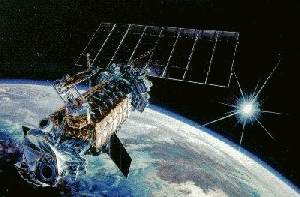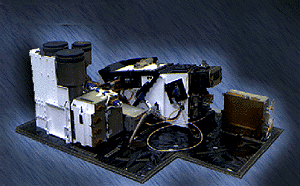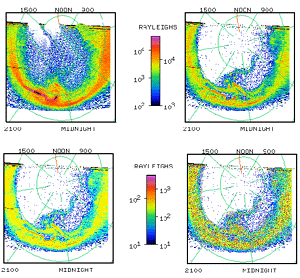Overview

The Johns Hopkins University Applied Physics Laboratory developed five remote sensing instruments for the Air Force Defense Meteorological Satellite Program (DMSP). The instruments known as Special Sensor Ultraviolet Spectrographic Imagers (SSUSI) fly on the DMSP-Block 5D3 satellites over a projected twenty year timespan. The first flight launched on October 18, 2003.
SSUSI remotely senses the physical and chemical processes in the Earth's upper atmosphere. Measurements are made from the extreme ultraviolet (EUV) to the far ultraviolet (FUV) over the wavelength range of 80 nm to 170 nm, with 1.8 nm resolution. The DMSP satellites are launched in near-polar, sun-synchronous orbits at an altitude of approximately 850 km. SSUSI was a prototype for GUVI which was launched on the TIMED spacecraft in December of 2001.
 |
 |
The Far UV Instrument SSUSI consists of an Ultraviolet Spectrographic Imaging System (SIS) with a spectral range of 115 to 180 nm and a Nadir-looking Photometer System (NPS). The NPS is unique in that it has filters at both 630 nm and 629.4 nm. This filter arrangement allows us to subtract out the effect of the ground albedo.
SSUSI provides information on the ionosphere and thermosphere by monitoring three general regions: the daytime low- to mid-latitude ionosphere and thermosphere, the nighttime low- to mid-latitude ionosphere and the high-latitude auroral zone. With the development of sophisticated remote sensing instruments capable of obtaining simultaneous monochromatic images at a number of wavelengths, and automated data processing techniques, it has become possible to routinely produce maps of the characteristics of the upper atmosphere.
SSUSI products include maps of the auroral oval, the characteristic energy and flux of the electrons which excite it, F-region ionospheric electron densities, and dayside neutral composition information. These products will be useful to DoD and civilian users and can support many basic research activities as well. With two decades of continuous coverage of the composition and dynamics of the upper atmosphere, we will have the unprecedented opportunity to study the effects of global climate change on the upper atmosphere.